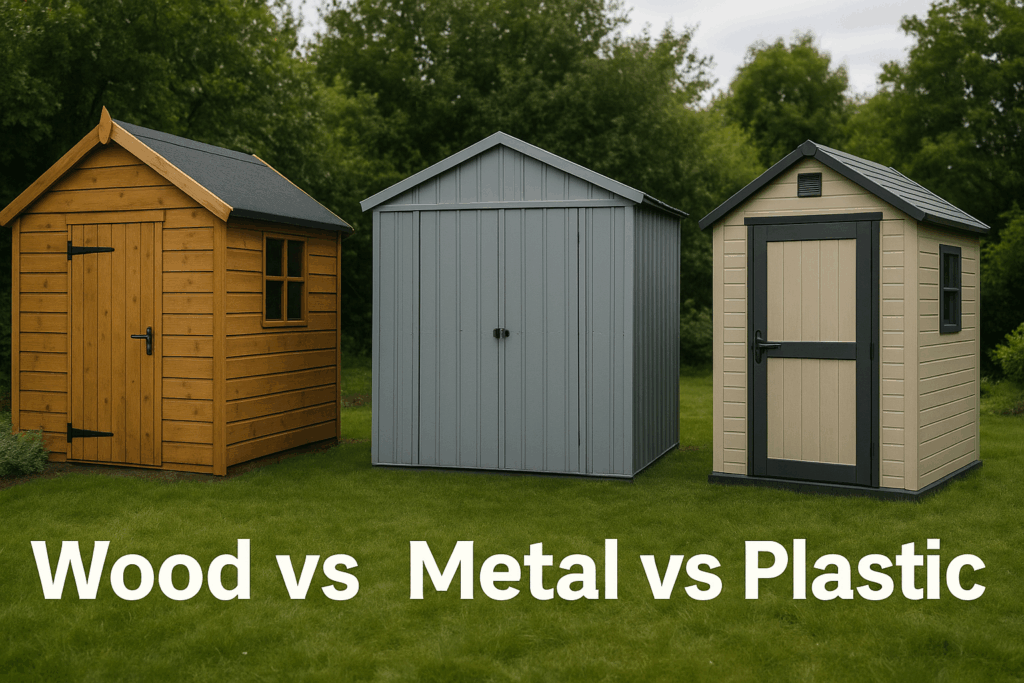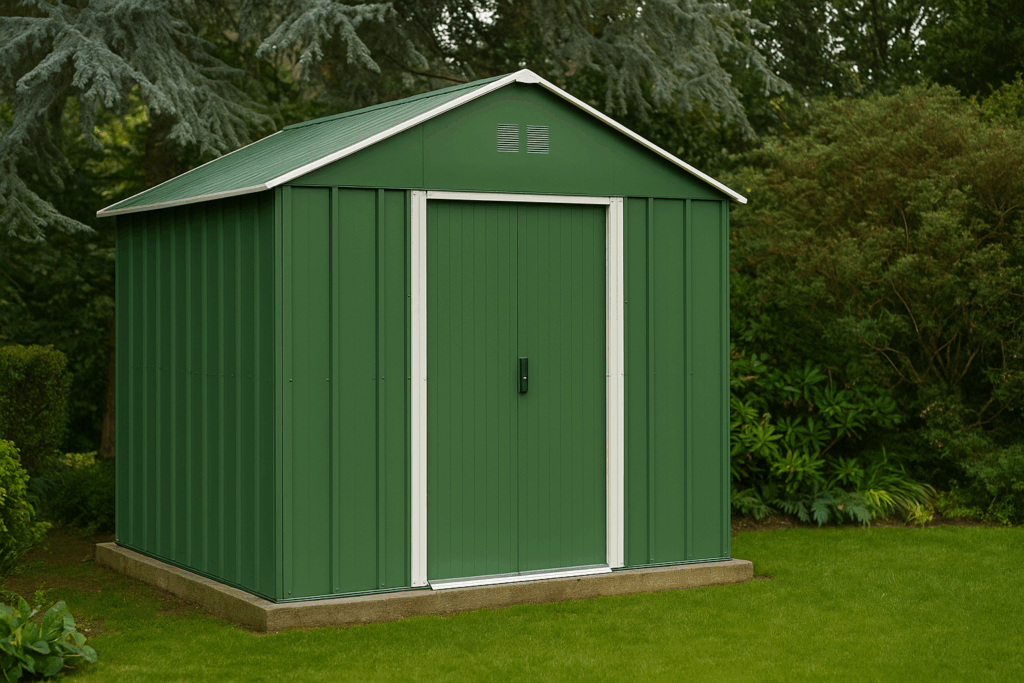
Choosing the best type of garden shed depends on what you value most — looks, security, or easy maintenance. Wooden, metal and plastic sheds all offer distinct pros and cons, so understanding the differences can save you time, money and effort in the long run.
Below, we compare the three main types of garden sheds to help you choose the right one for your space, budget and climate.
🏡 Quick Comparison Table
| Material | Durability | Maintenance | Appearance | Cost | Best For |
|---|---|---|---|---|---|
| Wood | ⭐⭐⭐⭐ | Needs regular treatment | Traditional, natural look | £££ (highest overall) | Classic style and custom builds |
| Metal | ⭐⭐⭐⭐⭐ | Very low | Modern or industrial | ££ (mid-range) | Security and long-term durability |
| Plastic (Resin) | ⭐⭐⭐ | None | Clean, contemporary | £ (lowest) | Low maintenance and quick setup |
🌿 Wooden Garden Sheds

Wooden sheds remain the most popular choice in UK gardens — and for good reason. They look natural, blend beautifully with greenery, and can be painted or stained to match any setting.
Pros:
- Warm, traditional appearance
- Easy to customise and repair
- Wide range of sizes and styles
Cons:
- Needs regular wood treatment
- Can rot or warp if poorly maintained
- Less secure than metal
- Most expensive overall once maintenance is factored in.
A wooden shed is often the best type of garden shed for those who value appearance and flexibility. It’s ideal for hobby spaces, workshops and larger gardens where looks matter as much as practicality.
🔒 Metal Garden Sheds

Metal sheds are built for strength and longevity. Typically made from galvanised steel or aluminium, they resist fire, pests and weather damage far better than wood.
Pros:
- Very secure and weather-resistant
- Long lifespan with minimal care
- Fire and pest resistant
Cons:
- Can suffer condensation if not ventilated
- Heavier to move once installed
- Industrial look may not suit all gardens
If security is your priority, a metal shed is arguably the best type of garden shed. It’s perfect for storing expensive tools, bikes or equipment that need extra protection.
⚙️ Plastic (Resin) Garden Sheds

Plastic sheds — often made from high-density resin — are the easiest to live with. They don’t rust, rot, or need painting, and can be assembled in a few hours with basic tools.
Pros:
- Zero maintenance
- Lightweight and easy to assemble
- Weatherproof and UV-stable
Cons:
- Not as strong as metal
- Limited size options
- May discolour over time
For anyone who wants a quick, affordable and tidy storage space, a plastic shed can be the best type of garden shed for low-effort convenience.
⚖️ Verdict: Which Is the Best Type of Garden Shed?
Each shed material has its strengths — the best type of garden shed ultimately depends on how you’ll use it:
- Choose wood for a classic look and easy customisation.
- Choose metal for strength, security and all-weather durability.
- Choose plastic for zero-maintenance storage and small spaces.
If you’re unsure, think about how long you plan to keep the shed, and how much upkeep you’re prepared to do each year.
For further expert advice on long-term maintenance for garden sheds, see the Landscaping Superstore’s guide to shed maintenance.
🔗 Related Articles
- Best Wooden Garden Sheds UK
Explore top-quality timber sheds that balance charm with practicality. - Best Metal Garden Sheds UK
Discover long-lasting steel and aluminium sheds for secure storage. - Best Plastic Garden Sheds UK
See low-maintenance resin sheds ideal for compact gardens. - Do You Need Planning Permission for a Garden Shed in the UK?
Check the current UK shed size and placement rules before you buy.
🏡 Explore More HomeGrower Hubs
Dive deeper into our core growing and self-sufficiency guides:
- Indoor Growing UK
Everything you need to grow herbs, vegetables, and microgreens indoors all year round. - Grow Lights UK
Compare LED, fluorescent, and full-spectrum grow lights for home growers. - Greenhouses & Polytunnels UK Resource Hub
Expert advice, product picks, and setup guides for year-round food growing.
Or return to the HomeGrower homepage to browse all our latest guides and reviews.
❓FAQs – Choosing the Best Type of Garden Shed
What type of shed lasts the longest?
Metal sheds usually last the longest thanks to their rust-resistant coatings and minimal upkeep. However, a well-built wooden shed can also last decades if regularly treated and raised off damp ground.
Are plastic sheds strong enough for UK weather?
Yes, modern plastic (resin) sheds are designed to withstand wind and rain. However, they’re lighter than wood or metal, so anchoring them securely to a base is essential.
Do metal sheds suffer from condensation?
They can, especially in cold or damp conditions. Adding vents or an insulation layer helps reduce condensation and protects tools from moisture.
Do I need planning permission for a garden shed?
Most garden sheds fall under permitted development rules, so planning permission isn’t usually required. Just ensure the shed is under 2.5 m high and doesn’t take up more than half your garden.
Which type of shed needs the least maintenance?
Plastic sheds need virtually no maintenance — just an occasional wash. Metal sheds need little attention beyond checking for scratches or rust, while wooden sheds require annual treatment.
What’s the best base for a garden shed?
A solid, level base of concrete, paving slabs, or compacted gravel keeps the shed stable and prevents moisture damage. Avoid placing it directly on soil.
Can I paint or customise plastic and metal sheds?
Plastic sheds aren’t designed for painting, but some specialist paints can be used. Metal sheds can be painted with rust-resistant exterior paint, while wooden sheds are easiest to customise with colour and fittings.
Is a wooden or metal shed better?
It depends on your priorities. Wooden sheds look more traditional and are easier to repair or customise, while metal sheds offer greater strength, security and weather resistance with far less maintenance.
What is the best shed for a small garden?
Plastic sheds are ideal for smaller gardens — they’re lightweight, compact and maintenance-free. For a more traditional look, a small overlap wooden shed can work well if you keep it raised on a firm base.
